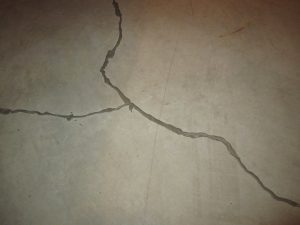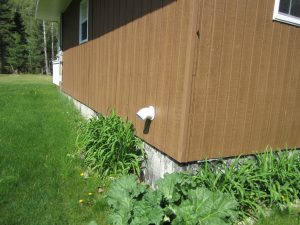Debra Bear-Brideau is a mother-of-two who lives on the Tobique First Nation, a community in northwestern New Brunswick. Along with other buildings in the First Nation, her home was tested for radon a year ago. The results showed that Debra’s home had the highest level of indoor radon exposure out of the entire community. Radon is a naturally occurring gas that’s odorless and colorless. It’s generally harmless outside but indoor radon exposure can be extremely unhealthy and may lead to lung cancer. After losing a family pet to the disease, Debra fears for her children’s health and her own.
Tobique First Nation is a Maliseet community located on the north side of the Tobique River in New Brunswick.
It has approximately 2,000 members, with close to 1,500 living on-reserve.
As part of Health Canada’s National Radon Program testing, six public or federal buildings on the First Nation community werre tested for indoor radon gas a year ago.
Five of these buildings – including the community’s daycare, healing lodge and wellness centre – had high elevated levels of radon.
Health Canada and Aboriginal Affairs and Northern Development Canada worked with the community to address the high radon exposure in the buildings.
Given the anxiety by residents felt over Health Canada’s test results, a survey of homes was also initiated (home testing is not part of the National Strategy).
According to the Tobique First Nation Residential Radon Report, a high percentage of the homes hadhigh radon levels. (Original report posted below)
Debra Bear-Brideau’s home had the highest level of indoor radon gas. Although her home got the work needed to fix the radon levels, she continues to worry about her family’s safety.
“We live in such an area with so much radon, that there’s always the possibility of it building back up again during winter,” says Bear-Brideau.
“It’s kinda scary this invisible gas can come in your house and hurt your kids and family.”
Radon gas is an invisible, colourless and tasteless gas formed by the breakdown of uranium in rocks and soil.
“Within the province, areas that have certain types of rock (shale and granite) and soil can have higher levels of uranium in the ground, leading to more radon,” says Dr. Mariane Paquet, medical officer of health for northern New Brunswick.
Radon gas is measured in becquerels per cubic metre (Bqm3). Higher numbers of becquerels mean higher levels of radon gas in the air.
“Since it is a gas, it can move freely through the soil enabling it to escape into the atmosphere or seep into buildings,” says Dr. Paquet.
Health Canada says remedial measures should be taken in a home or building when the radon concentration exceeds 200 Bq/m3.
Bear-Brideau’s home – like so many others in New Brunswick – had among the highest indoor radon concentrations in the country.
A cross-Canada project by the National Radon Program surveyed 14,000 homes over a two-year period (2009-2011).
18.7 per cent of New Brunswick homes tested had between 200-600 Bq/m3 of radon, 6.1 per cent had levels above 600 Bq/m3.
Nova Scotia had the second highest percentages of indoor radon, followed by Newfoundland and Labrador and PEI.
By health regions, Tobique First Nation located within the Fredericton area (Health Region 3) had a whopping 16.5 per cent of houses with radon levels above 600Bq/m3.
Despite work being done to raise awareness about radon and radon testing, it seems there still a long way to go.
“I don’t think a lot of First Nations communities do radon testing,”says Sterling Perly, executive director of programs for the Tobique First Nation.
Simon Osmond, senior policy analyst with the Atlantic Policy Congress of First Nation Chiefs agrees.
“I know Health Canada and CMHC at different times have provided some information. The thing is information can only go so far especially for cash stricken communities already trying to address other issues,” says Osmond.
Through an environmental survey, Statistics Canada asked Canadians by province how many were aware of radon and radon testing. In New Brunswick, most knew radon was a health hazard and could describe the radioactive gas.
But ninety-five per cent had not tested for radon.
Bear-Brideau says she knew what radon was, but never knew it was in her house.
“My mother Pauline Bear asked a specialist about radon in the early 1980’s, but was told there wasn’t any radon around this area,” she says.

“When I was in university I also inquired about radon in this area and was told the same thing. I had an inkling there was more to my fatigue and feeling unwell.”
She explains how she often she has sinus problems and how her daughter has had pneumonia several times – leaving her to wonder if it is related to the radon.
Recently, Health Canada reported that more than 3000 lung cancer deaths may be linked to indoor radon exposure.
That doesn’t sit well Bear-Brideau.
“She had lung cancer. It hit her really quick,” says Bear-Brideau of their family ferret.
“All of a sudden she was coughing funny. I took her to the vet and the vet said she died of lung cancer. I’m concerned eventually I’ll go to the hospital one of these days and they’ll say you have lung cancer.”
Kelley Bush, head of radon education and awareness for Health Canada, says the federal government is doing everything it can to raise awareness about radon and radon testing.

“In the Atlantic region, we’re have partners with the Lung Association. They sell test kits for thirty-five dollars that includes the analysis too,” says Bush.
Roshini Kassie, manager at the New Brunswick Lung Association has even gone as far as mailing test kits across the country.
“It doesn’t prevent someone calling from PEI to call the New Brunswick Association to order a test kit or they can go on our Facebook page and order them,” says Kassie.
Although close to 200 radon tests are waiting to be collected for analysis at the Tobique First Nation, the community is taking the lead on raising awareness about radon and radon testing.
Health Canada is currently testing federal workplaces until the end of March 2013. A report is expected to be released at this time.
But in the meantime, Bear-Brideau says she will continue to leave her windows open as a precaution – even in winter.
